Nursing Research 2 Final Project: Evaluation of Study 3 for EBP
VerifiedAdded on 2023/02/01
|9
|2269
|60
Report
AI Summary
This report presents a critical evaluation of the qualitative research study titled "Exploring the perspectives of allied health practitioners toward the use of journal clubs as a medium for promoting evidence-based practice: a qualitative study." The evaluation assesses the study's credibility, problem statement, research design, ethical considerations, purpose, literature review, sampling strategies, data trustworthiness, and the potential for application in evidence-based practice. The analysis highlights the strengths of the study, such as its credible authors and the use of a peer-reviewed publication, while also pointing out areas for improvement, particularly concerning the currency of the literature review. The report concludes that the study offers valuable insights for promoting evidence-based practice and provides recommendations for future research and implementation strategies, specifically focusing on the use of journal clubs to improve patient care within allied health settings. The report follows the structure of the assignment brief, which includes an introduction, a section-by-section analysis based on the grading rubric, and a conclusion.

Running head: Nursing Research 1
Final Project Overview-Study 3
(Author’s name)
(Institutional Affiliation)
Final Project Overview-Study 3
(Author’s name)
(Institutional Affiliation)
Paraphrase This Document
Need a fresh take? Get an instant paraphrase of this document with our AI Paraphraser
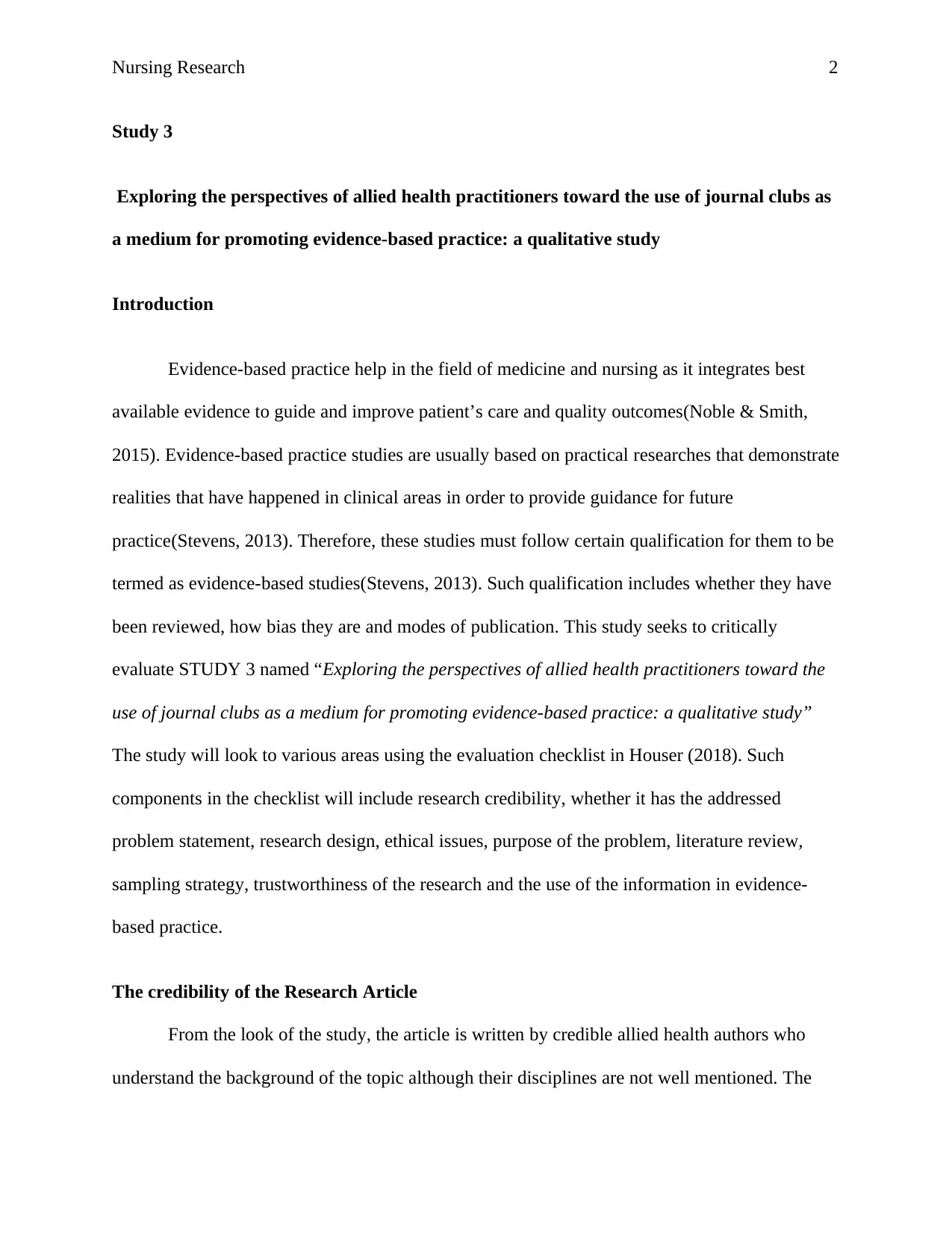
Nursing Research 2
Study 3
Exploring the perspectives of allied health practitioners toward the use of journal clubs as
a medium for promoting evidence-based practice: a qualitative study
Introduction
Evidence-based practice help in the field of medicine and nursing as it integrates best
available evidence to guide and improve patient’s care and quality outcomes(Noble & Smith,
2015). Evidence-based practice studies are usually based on practical researches that demonstrate
realities that have happened in clinical areas in order to provide guidance for future
practice(Stevens, 2013). Therefore, these studies must follow certain qualification for them to be
termed as evidence-based studies(Stevens, 2013). Such qualification includes whether they have
been reviewed, how bias they are and modes of publication. This study seeks to critically
evaluate STUDY 3 named “Exploring the perspectives of allied health practitioners toward the
use of journal clubs as a medium for promoting evidence-based practice: a qualitative study”
The study will look to various areas using the evaluation checklist in Houser (2018). Such
components in the checklist will include research credibility, whether it has the addressed
problem statement, research design, ethical issues, purpose of the problem, literature review,
sampling strategy, trustworthiness of the research and the use of the information in evidence-
based practice.
The credibility of the Research Article
From the look of the study, the article is written by credible allied health authors who
understand the background of the topic although their disciplines are not well mentioned. The
Study 3
Exploring the perspectives of allied health practitioners toward the use of journal clubs as
a medium for promoting evidence-based practice: a qualitative study
Introduction
Evidence-based practice help in the field of medicine and nursing as it integrates best
available evidence to guide and improve patient’s care and quality outcomes(Noble & Smith,
2015). Evidence-based practice studies are usually based on practical researches that demonstrate
realities that have happened in clinical areas in order to provide guidance for future
practice(Stevens, 2013). Therefore, these studies must follow certain qualification for them to be
termed as evidence-based studies(Stevens, 2013). Such qualification includes whether they have
been reviewed, how bias they are and modes of publication. This study seeks to critically
evaluate STUDY 3 named “Exploring the perspectives of allied health practitioners toward the
use of journal clubs as a medium for promoting evidence-based practice: a qualitative study”
The study will look to various areas using the evaluation checklist in Houser (2018). Such
components in the checklist will include research credibility, whether it has the addressed
problem statement, research design, ethical issues, purpose of the problem, literature review,
sampling strategy, trustworthiness of the research and the use of the information in evidence-
based practice.
The credibility of the Research Article
From the look of the study, the article is written by credible allied health authors who
understand the background of the topic although their disciplines are not well mentioned. The

Nursing Research 3
article is published by BioMed Central which is a well-known website that publishes credible
medical journals. The article indicates well how the data was collected, analysis and results
showing no evidence of biases(Stevens, 2013). Other than that, the authors clearly highlight at
the end of the article that they had no conflicts of interest(Lizarondo, Grimmer-Somers, &
Kumar, 2011). The article journal has page numbers from one to eleven, year of publication in
2011, volume number one and has various authors who read and approved it indicating it is a
peer-reviewed article. Although the dates of the study have not been mentioned, the received
dates and the published dates have a difference of three days showing the study was conducted
and presented in the right manner(Lizarondo et al., 2011).
Problem Statement and Research Design
The article has clearly defined the produced problem by narrowing from the broader
perspective to the main point(Stevens, 2013). The article starts by defining the broader topic
which is significant and uses of the journal clubs (JCs) in enhancing evidence-based practice
EBP. The application of JCs in nursing has been portrayed which include appraising different
articles by various members of the JCs to enhance and produce evidenced-based
solutions(Lizarondo et al., 2011). Narrowing to the topic, the authors have described the
traditional model of journal club up to an innovative model of journal club that is commonly
used in South Australia which includes the International Centre for Allied Health Evidence
(ICAHE). The authors have clearly explained the benefits of ICAHE and the gap that exist that
can be spotted easily in the article. Some of the significant of ICAHE include the promotion of
ongoing attendance, enhancing questions formulation, searching of evidence, implementation,
and evaluation(Lizarondo et al., 2011). In addition, the researchers have also demonstrated the
existing gaps for the research which include potential threats that usually hinder ongoing
article is published by BioMed Central which is a well-known website that publishes credible
medical journals. The article indicates well how the data was collected, analysis and results
showing no evidence of biases(Stevens, 2013). Other than that, the authors clearly highlight at
the end of the article that they had no conflicts of interest(Lizarondo, Grimmer-Somers, &
Kumar, 2011). The article journal has page numbers from one to eleven, year of publication in
2011, volume number one and has various authors who read and approved it indicating it is a
peer-reviewed article. Although the dates of the study have not been mentioned, the received
dates and the published dates have a difference of three days showing the study was conducted
and presented in the right manner(Lizarondo et al., 2011).
Problem Statement and Research Design
The article has clearly defined the produced problem by narrowing from the broader
perspective to the main point(Stevens, 2013). The article starts by defining the broader topic
which is significant and uses of the journal clubs (JCs) in enhancing evidence-based practice
EBP. The application of JCs in nursing has been portrayed which include appraising different
articles by various members of the JCs to enhance and produce evidenced-based
solutions(Lizarondo et al., 2011). Narrowing to the topic, the authors have described the
traditional model of journal club up to an innovative model of journal club that is commonly
used in South Australia which includes the International Centre for Allied Health Evidence
(ICAHE). The authors have clearly explained the benefits of ICAHE and the gap that exist that
can be spotted easily in the article. Some of the significant of ICAHE include the promotion of
ongoing attendance, enhancing questions formulation, searching of evidence, implementation,
and evaluation(Lizarondo et al., 2011). In addition, the researchers have also demonstrated the
existing gaps for the research which include potential threats that usually hinder ongoing
⊘ This is a preview!⊘
Do you want full access?
Subscribe today to unlock all pages.

Trusted by 1+ million students worldwide
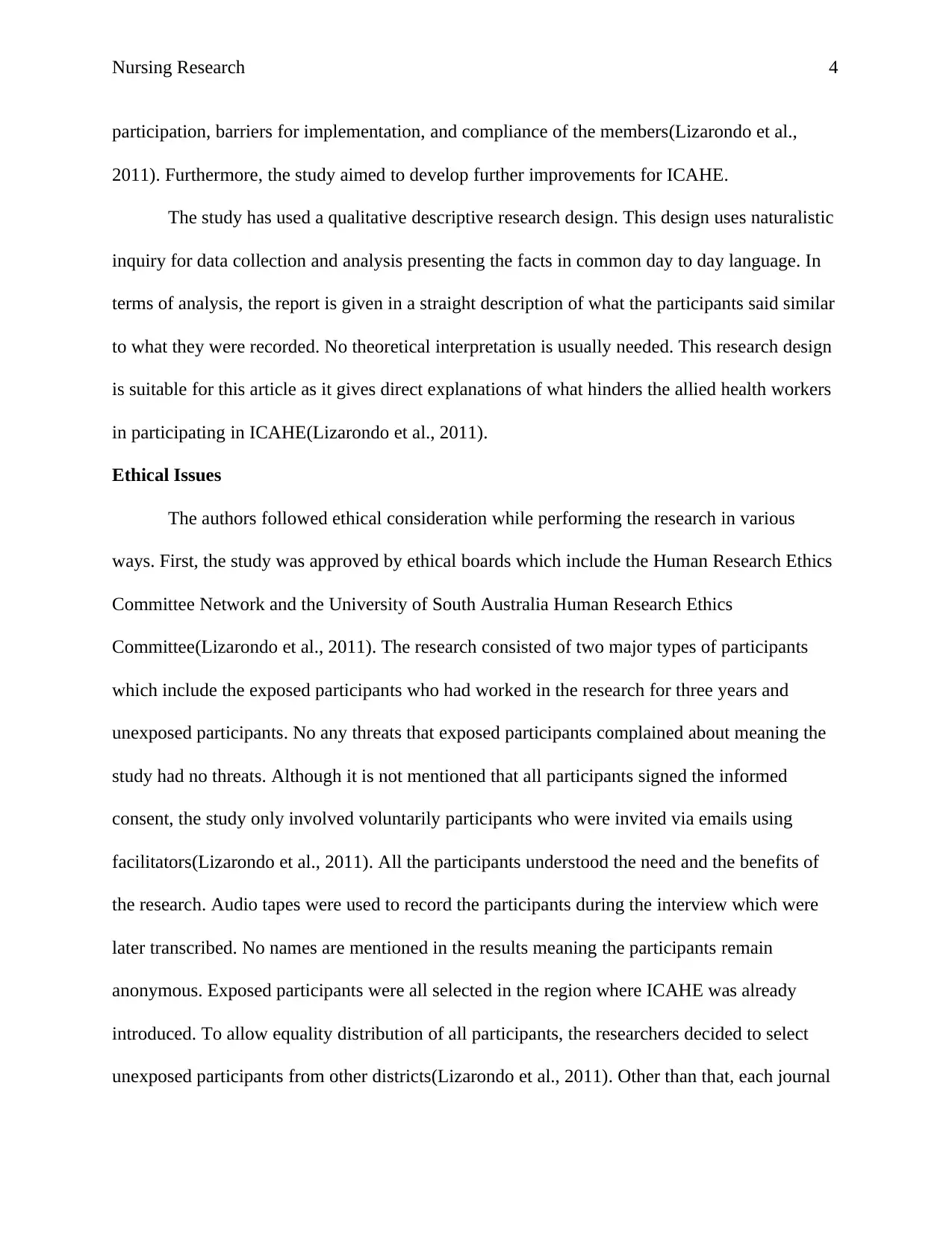
Nursing Research 4
participation, barriers for implementation, and compliance of the members(Lizarondo et al.,
2011). Furthermore, the study aimed to develop further improvements for ICAHE.
The study has used a qualitative descriptive research design. This design uses naturalistic
inquiry for data collection and analysis presenting the facts in common day to day language. In
terms of analysis, the report is given in a straight description of what the participants said similar
to what they were recorded. No theoretical interpretation is usually needed. This research design
is suitable for this article as it gives direct explanations of what hinders the allied health workers
in participating in ICAHE(Lizarondo et al., 2011).
Ethical Issues
The authors followed ethical consideration while performing the research in various
ways. First, the study was approved by ethical boards which include the Human Research Ethics
Committee Network and the University of South Australia Human Research Ethics
Committee(Lizarondo et al., 2011). The research consisted of two major types of participants
which include the exposed participants who had worked in the research for three years and
unexposed participants. No any threats that exposed participants complained about meaning the
study had no threats. Although it is not mentioned that all participants signed the informed
consent, the study only involved voluntarily participants who were invited via emails using
facilitators(Lizarondo et al., 2011). All the participants understood the need and the benefits of
the research. Audio tapes were used to record the participants during the interview which were
later transcribed. No names are mentioned in the results meaning the participants remain
anonymous. Exposed participants were all selected in the region where ICAHE was already
introduced. To allow equality distribution of all participants, the researchers decided to select
unexposed participants from other districts(Lizarondo et al., 2011). Other than that, each journal
participation, barriers for implementation, and compliance of the members(Lizarondo et al.,
2011). Furthermore, the study aimed to develop further improvements for ICAHE.
The study has used a qualitative descriptive research design. This design uses naturalistic
inquiry for data collection and analysis presenting the facts in common day to day language. In
terms of analysis, the report is given in a straight description of what the participants said similar
to what they were recorded. No theoretical interpretation is usually needed. This research design
is suitable for this article as it gives direct explanations of what hinders the allied health workers
in participating in ICAHE(Lizarondo et al., 2011).
Ethical Issues
The authors followed ethical consideration while performing the research in various
ways. First, the study was approved by ethical boards which include the Human Research Ethics
Committee Network and the University of South Australia Human Research Ethics
Committee(Lizarondo et al., 2011). The research consisted of two major types of participants
which include the exposed participants who had worked in the research for three years and
unexposed participants. No any threats that exposed participants complained about meaning the
study had no threats. Although it is not mentioned that all participants signed the informed
consent, the study only involved voluntarily participants who were invited via emails using
facilitators(Lizarondo et al., 2011). All the participants understood the need and the benefits of
the research. Audio tapes were used to record the participants during the interview which were
later transcribed. No names are mentioned in the results meaning the participants remain
anonymous. Exposed participants were all selected in the region where ICAHE was already
introduced. To allow equality distribution of all participants, the researchers decided to select
unexposed participants from other districts(Lizarondo et al., 2011). Other than that, each journal
Paraphrase This Document
Need a fresh take? Get an instant paraphrase of this document with our AI Paraphraser

Nursing Research 5
club consisted of six to twelve individuals creating a good figure for equitable distribution of
individuals.
Purpose Statement
From the problem statement which was the availability of various issues that usually
hinders participation in JCs especially ICAHE, the aim of the study came up following the gap
created. The study major purpose is written in the article as a statement which includes exploring
the views and perspectives of allied health professionals about the use of any type of JC in order
to promote evidence-based practice(Lizarondo et al., 2011). Additionally, the study specifically
states another secondary aim which included how the ICAHE model can be improved. The study
has clearly described the study design, a qualitative descriptive design, ethical issues are well
outlined and the setting is specified(Lizarondo et al., 2011). The study design and the purpose are
obviously aligned with each other since the purpose involved understanding the direct
description of what participants think about the research(Stevens, 2013). The research is done in
a clinical setting involving allied health workers professionals only. The exposed number is
mentioned which include 250 participants(Lizarondo et al., 2011). All the required resources and
people are readily available and are mentioned making the study feasible.
Literature Review
The literature review relies mostly on primary sources conducted within the last five
years. The article has used a total of forty-four references of which only nine of them range
between the year 2006 to 2011 at which the article was published(Lizarondo et al., 2011).
Checking on that matter, the study did not use current evidence when conducting the literature
review. However, in the literature review, the authors clearly demonstrate the relationship
between traditionally used JCs in the literature and the most current one which is ICAHE. Other
club consisted of six to twelve individuals creating a good figure for equitable distribution of
individuals.
Purpose Statement
From the problem statement which was the availability of various issues that usually
hinders participation in JCs especially ICAHE, the aim of the study came up following the gap
created. The study major purpose is written in the article as a statement which includes exploring
the views and perspectives of allied health professionals about the use of any type of JC in order
to promote evidence-based practice(Lizarondo et al., 2011). Additionally, the study specifically
states another secondary aim which included how the ICAHE model can be improved. The study
has clearly described the study design, a qualitative descriptive design, ethical issues are well
outlined and the setting is specified(Lizarondo et al., 2011). The study design and the purpose are
obviously aligned with each other since the purpose involved understanding the direct
description of what participants think about the research(Stevens, 2013). The research is done in
a clinical setting involving allied health workers professionals only. The exposed number is
mentioned which include 250 participants(Lizarondo et al., 2011). All the required resources and
people are readily available and are mentioned making the study feasible.
Literature Review
The literature review relies mostly on primary sources conducted within the last five
years. The article has used a total of forty-four references of which only nine of them range
between the year 2006 to 2011 at which the article was published(Lizarondo et al., 2011).
Checking on that matter, the study did not use current evidence when conducting the literature
review. However, in the literature review, the authors clearly demonstrate the relationship
between traditionally used JCs in the literature and the most current one which is ICAHE. Other
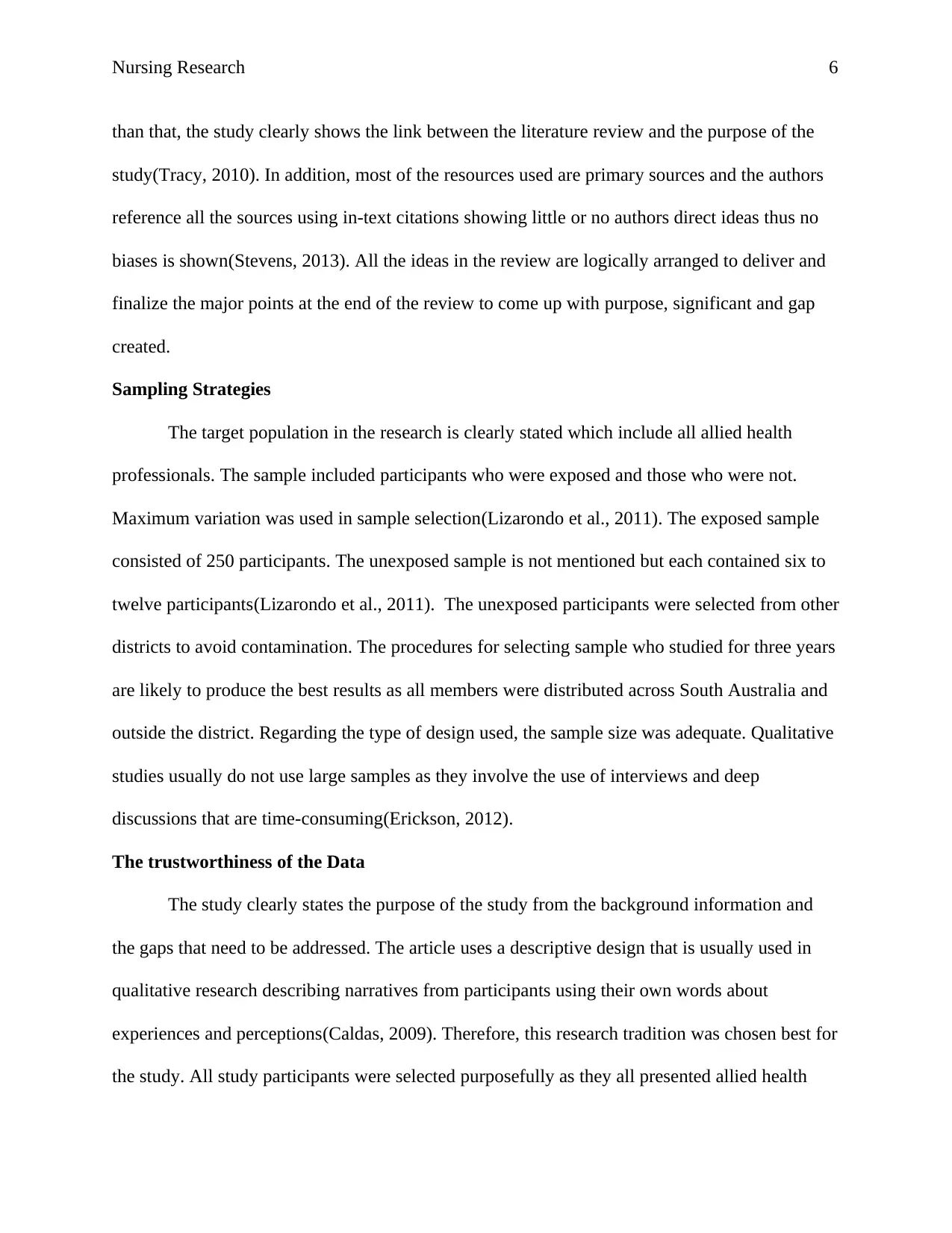
Nursing Research 6
than that, the study clearly shows the link between the literature review and the purpose of the
study(Tracy, 2010). In addition, most of the resources used are primary sources and the authors
reference all the sources using in-text citations showing little or no authors direct ideas thus no
biases is shown(Stevens, 2013). All the ideas in the review are logically arranged to deliver and
finalize the major points at the end of the review to come up with purpose, significant and gap
created.
Sampling Strategies
The target population in the research is clearly stated which include all allied health
professionals. The sample included participants who were exposed and those who were not.
Maximum variation was used in sample selection(Lizarondo et al., 2011). The exposed sample
consisted of 250 participants. The unexposed sample is not mentioned but each contained six to
twelve participants(Lizarondo et al., 2011). The unexposed participants were selected from other
districts to avoid contamination. The procedures for selecting sample who studied for three years
are likely to produce the best results as all members were distributed across South Australia and
outside the district. Regarding the type of design used, the sample size was adequate. Qualitative
studies usually do not use large samples as they involve the use of interviews and deep
discussions that are time-consuming(Erickson, 2012).
The trustworthiness of the Data
The study clearly states the purpose of the study from the background information and
the gaps that need to be addressed. The article uses a descriptive design that is usually used in
qualitative research describing narratives from participants using their own words about
experiences and perceptions(Caldas, 2009). Therefore, this research tradition was chosen best for
the study. All study participants were selected purposefully as they all presented allied health
than that, the study clearly shows the link between the literature review and the purpose of the
study(Tracy, 2010). In addition, most of the resources used are primary sources and the authors
reference all the sources using in-text citations showing little or no authors direct ideas thus no
biases is shown(Stevens, 2013). All the ideas in the review are logically arranged to deliver and
finalize the major points at the end of the review to come up with purpose, significant and gap
created.
Sampling Strategies
The target population in the research is clearly stated which include all allied health
professionals. The sample included participants who were exposed and those who were not.
Maximum variation was used in sample selection(Lizarondo et al., 2011). The exposed sample
consisted of 250 participants. The unexposed sample is not mentioned but each contained six to
twelve participants(Lizarondo et al., 2011). The unexposed participants were selected from other
districts to avoid contamination. The procedures for selecting sample who studied for three years
are likely to produce the best results as all members were distributed across South Australia and
outside the district. Regarding the type of design used, the sample size was adequate. Qualitative
studies usually do not use large samples as they involve the use of interviews and deep
discussions that are time-consuming(Erickson, 2012).
The trustworthiness of the Data
The study clearly states the purpose of the study from the background information and
the gaps that need to be addressed. The article uses a descriptive design that is usually used in
qualitative research describing narratives from participants using their own words about
experiences and perceptions(Caldas, 2009). Therefore, this research tradition was chosen best for
the study. All study participants were selected purposefully as they all presented allied health
⊘ This is a preview!⊘
Do you want full access?
Subscribe today to unlock all pages.

Trusted by 1+ million students worldwide
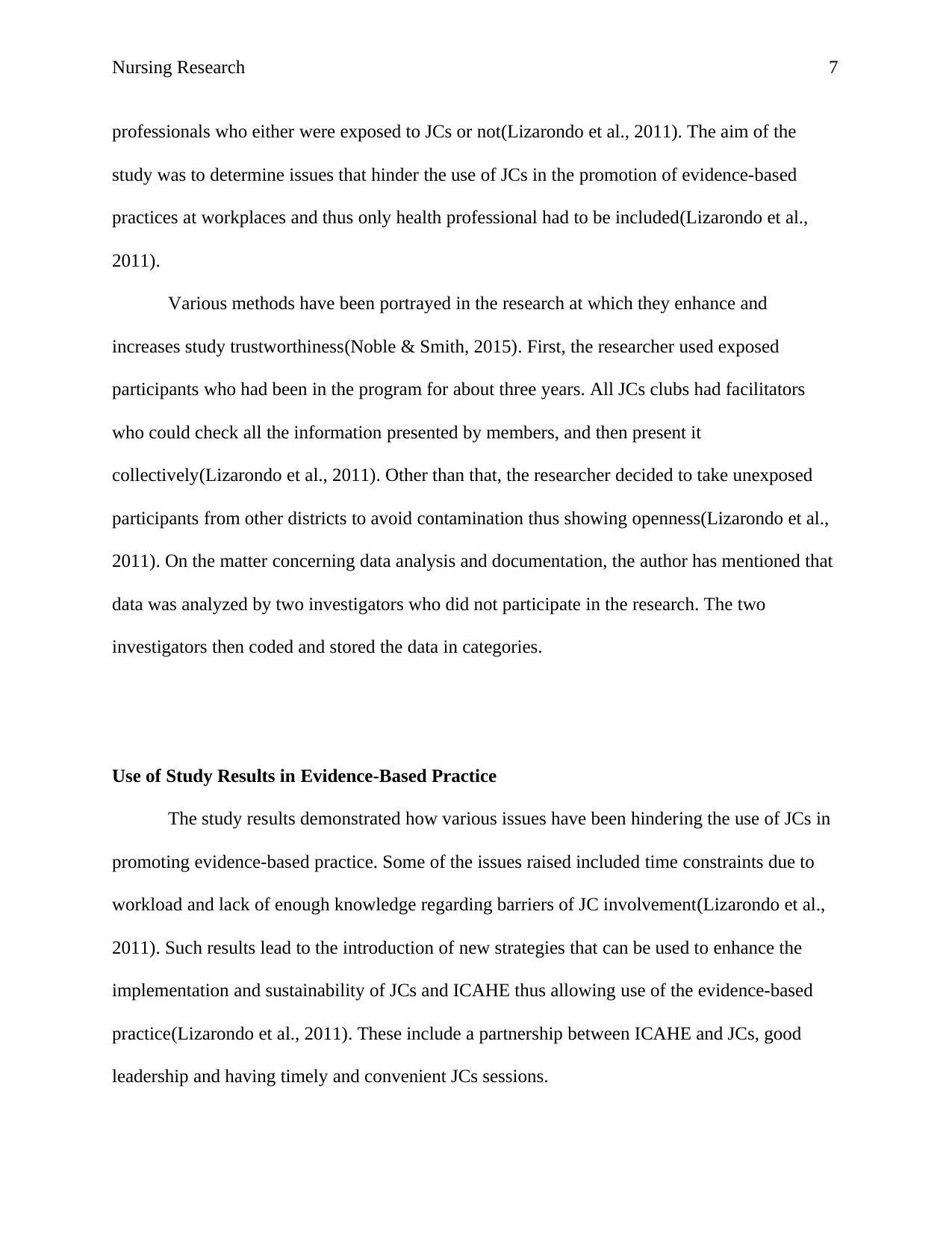
Nursing Research 7
professionals who either were exposed to JCs or not(Lizarondo et al., 2011). The aim of the
study was to determine issues that hinder the use of JCs in the promotion of evidence-based
practices at workplaces and thus only health professional had to be included(Lizarondo et al.,
2011).
Various methods have been portrayed in the research at which they enhance and
increases study trustworthiness(Noble & Smith, 2015). First, the researcher used exposed
participants who had been in the program for about three years. All JCs clubs had facilitators
who could check all the information presented by members, and then present it
collectively(Lizarondo et al., 2011). Other than that, the researcher decided to take unexposed
participants from other districts to avoid contamination thus showing openness(Lizarondo et al.,
2011). On the matter concerning data analysis and documentation, the author has mentioned that
data was analyzed by two investigators who did not participate in the research. The two
investigators then coded and stored the data in categories.
Use of Study Results in Evidence-Based Practice
The study results demonstrated how various issues have been hindering the use of JCs in
promoting evidence-based practice. Some of the issues raised included time constraints due to
workload and lack of enough knowledge regarding barriers of JC involvement(Lizarondo et al.,
2011). Such results lead to the introduction of new strategies that can be used to enhance the
implementation and sustainability of JCs and ICAHE thus allowing use of the evidence-based
practice(Lizarondo et al., 2011). These include a partnership between ICAHE and JCs, good
leadership and having timely and convenient JCs sessions.
professionals who either were exposed to JCs or not(Lizarondo et al., 2011). The aim of the
study was to determine issues that hinder the use of JCs in the promotion of evidence-based
practices at workplaces and thus only health professional had to be included(Lizarondo et al.,
2011).
Various methods have been portrayed in the research at which they enhance and
increases study trustworthiness(Noble & Smith, 2015). First, the researcher used exposed
participants who had been in the program for about three years. All JCs clubs had facilitators
who could check all the information presented by members, and then present it
collectively(Lizarondo et al., 2011). Other than that, the researcher decided to take unexposed
participants from other districts to avoid contamination thus showing openness(Lizarondo et al.,
2011). On the matter concerning data analysis and documentation, the author has mentioned that
data was analyzed by two investigators who did not participate in the research. The two
investigators then coded and stored the data in categories.
Use of Study Results in Evidence-Based Practice
The study results demonstrated how various issues have been hindering the use of JCs in
promoting evidence-based practice. Some of the issues raised included time constraints due to
workload and lack of enough knowledge regarding barriers of JC involvement(Lizarondo et al.,
2011). Such results lead to the introduction of new strategies that can be used to enhance the
implementation and sustainability of JCs and ICAHE thus allowing use of the evidence-based
practice(Lizarondo et al., 2011). These include a partnership between ICAHE and JCs, good
leadership and having timely and convenient JCs sessions.
Paraphrase This Document
Need a fresh take? Get an instant paraphrase of this document with our AI Paraphraser

Nursing Research 8
Conclusion
In conclusion, using the checklist components in Houser 2018, the above study qualifies
to be categorized as one of the qualitative evidence-based research. The study covers most
components in the checklist leaving only a few. For instance, the study shows no evidence of
bias and all the research about the Journal Clubs and ICAHE were done and counterchecked by
various authors. Other than that, the study can be used to facilitate evidence-based practice as it
has given various recommendations and gaps for more studies.
Conclusion
In conclusion, using the checklist components in Houser 2018, the above study qualifies
to be categorized as one of the qualitative evidence-based research. The study covers most
components in the checklist leaving only a few. For instance, the study shows no evidence of
bias and all the research about the Journal Clubs and ICAHE were done and counterchecked by
various authors. Other than that, the study can be used to facilitate evidence-based practice as it
has given various recommendations and gaps for more studies.
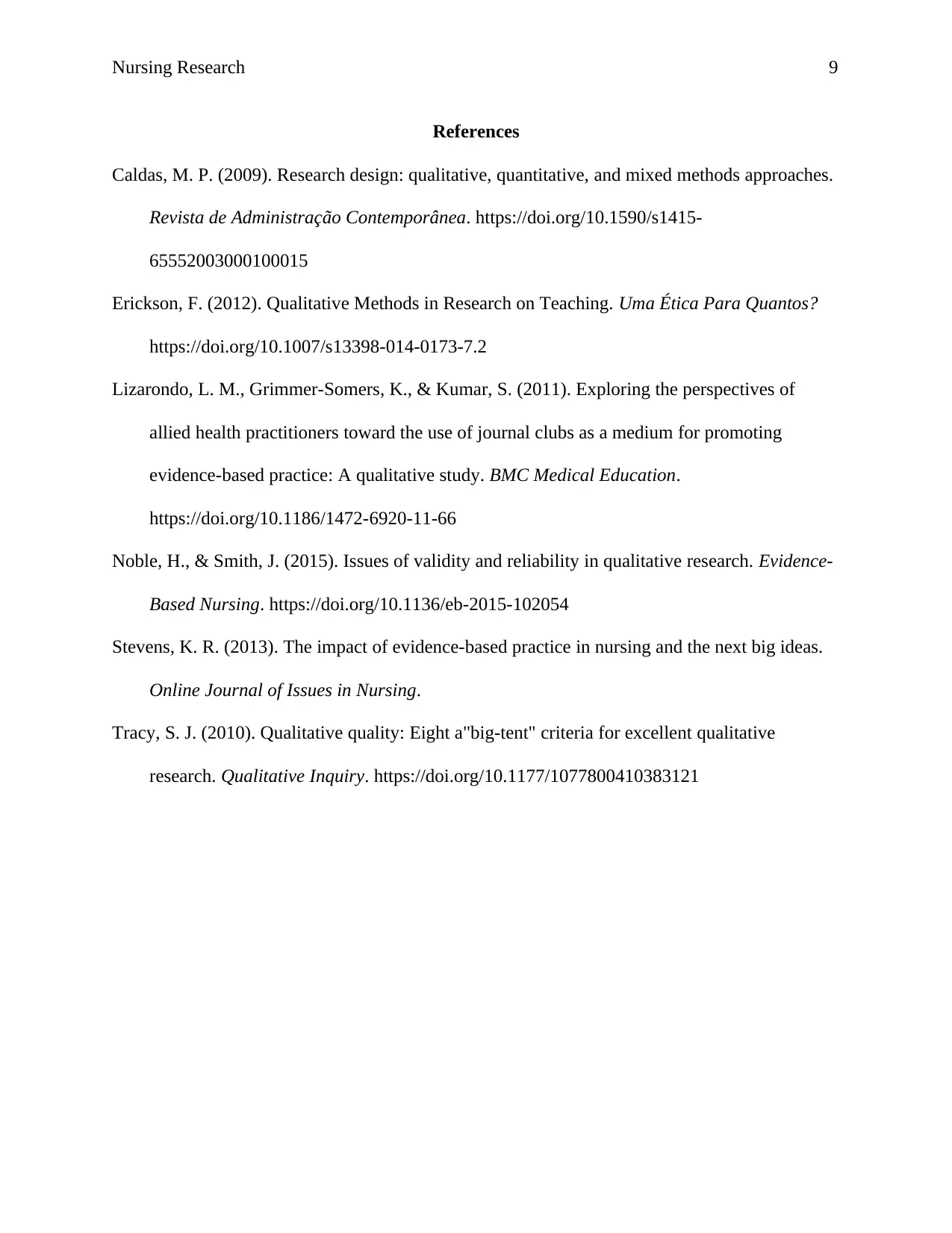
Nursing Research 9
References
Caldas, M. P. (2009). Research design: qualitative, quantitative, and mixed methods approaches.
Revista de Administração Contemporânea. https://doi.org/10.1590/s1415-
65552003000100015
Erickson, F. (2012). Qualitative Methods in Research on Teaching. Uma Ética Para Quantos?
https://doi.org/10.1007/s13398-014-0173-7.2
Lizarondo, L. M., Grimmer-Somers, K., & Kumar, S. (2011). Exploring the perspectives of
allied health practitioners toward the use of journal clubs as a medium for promoting
evidence-based practice: A qualitative study. BMC Medical Education.
https://doi.org/10.1186/1472-6920-11-66
Noble, H., & Smith, J. (2015). Issues of validity and reliability in qualitative research. Evidence-
Based Nursing. https://doi.org/10.1136/eb-2015-102054
Stevens, K. R. (2013). The impact of evidence-based practice in nursing and the next big ideas.
Online Journal of Issues in Nursing.
Tracy, S. J. (2010). Qualitative quality: Eight a"big-tent" criteria for excellent qualitative
research. Qualitative Inquiry. https://doi.org/10.1177/1077800410383121
References
Caldas, M. P. (2009). Research design: qualitative, quantitative, and mixed methods approaches.
Revista de Administração Contemporânea. https://doi.org/10.1590/s1415-
65552003000100015
Erickson, F. (2012). Qualitative Methods in Research on Teaching. Uma Ética Para Quantos?
https://doi.org/10.1007/s13398-014-0173-7.2
Lizarondo, L. M., Grimmer-Somers, K., & Kumar, S. (2011). Exploring the perspectives of
allied health practitioners toward the use of journal clubs as a medium for promoting
evidence-based practice: A qualitative study. BMC Medical Education.
https://doi.org/10.1186/1472-6920-11-66
Noble, H., & Smith, J. (2015). Issues of validity and reliability in qualitative research. Evidence-
Based Nursing. https://doi.org/10.1136/eb-2015-102054
Stevens, K. R. (2013). The impact of evidence-based practice in nursing and the next big ideas.
Online Journal of Issues in Nursing.
Tracy, S. J. (2010). Qualitative quality: Eight a"big-tent" criteria for excellent qualitative
research. Qualitative Inquiry. https://doi.org/10.1177/1077800410383121
⊘ This is a preview!⊘
Do you want full access?
Subscribe today to unlock all pages.

Trusted by 1+ million students worldwide
1 out of 9
Related Documents
Your All-in-One AI-Powered Toolkit for Academic Success.
+13062052269
info@desklib.com
Available 24*7 on WhatsApp / Email
![[object Object]](/_next/static/media/star-bottom.7253800d.svg)
Unlock your academic potential
Copyright © 2020–2025 A2Z Services. All Rights Reserved. Developed and managed by ZUCOL.





